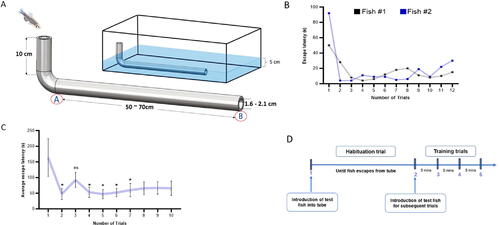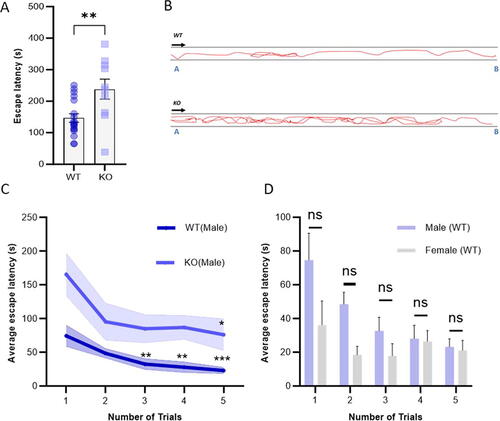- Title
-
A Simple Tube Escape Assay to Test Learning and Memory in Zebrafish with Minimized Habituation
- Authors
- Wellalage Don, D., Kim, T.Y., Hong, B.N., Lee, J.S., Kang, T.H., Gerlai, R., Kim, C.H.
- Source
- Full text @ Zebrafish
|
Experimental design of the tube assay and overview of zebrafish training. (A) Schematic diagram of the experimental setup with dimensions of the L-shaped tube indicated. Note that for the internal diameter, two values are given to correspond with the diameter of the tube used first (larger) and the subsequently used tube (smaller diameter). A single zebrafish was introduced into the vertical short arm of the tube. Placement of the tube inside the tank is shown (B) Time to escape from the tube, that is, length of time the fish took to traverse the distance from point A to point B (exit point) (s, seconds) is shown as a function of trials in the 70 cm long and 2.1 cm inner diameter tube. Results for two individual zebrafish, Fish #1 and Fish #2, are shown. (C) Average escape time for wild-type zebrafish over ten trials in the 70 cm tube with 1.6 cm diameter (n = 17). (D) Schematic representation of the optimized paradigm indicating the habituation and training trials. |
|
(A) Wild-type (WT, n = 18) and autism model (knockout [KO], n = 10) zebrafish at the first trial in the 70 cm long tube tunnel with 1.6 cm inner diameter. (B) Swim paths of fish recorded by video tracking (red line). The arrows indicate the dominant direction of movement. (C) Escape latency for wild-type male zebrafish (n = 24), wild-type female zebrafish (n = 10) and (D) Escape latency for wild-type male zebrafish and autism model zebrafish (KO, n = 10) over five trials in the shorter 50 cm tube. |
|
(A) Tube tunnel escape test after 1-hour inter-trial (memory retention) interval in the 50 cm tube with 1.6 cm diameter. Wild-type (n = 24) and autism model zebrafish (n = 10) escape latency is shown as a function of time (trials). Escape latency in the sixth trial for both groups measured after 1 hour from the last trial. Statistical significance (comparing escape latency at the 6th trial to that at the 1st trial) is shown as *p < 0.05. (B) Escape latencies of wild-type zebrafish (n = 14) trained over 3 days and long-term memory performance tested 4 days later, that is, on day 7 are shown. Statistical significance to evaluate whether escape latency remains reduced on the 7th day compared with the 1st day is shown as *p < 0.05. (C) Escape time for wild-type (n = 30) and autism KO model (n = 10) zebrafish in different colored tubes compared with the transparent tube (control). Mean + S.E.M. are shown. Statistical significance (comparing performance at a given trial to that at the first trial) is indicated as *p < 0.05, **p < 0.01, ***p < 0.001. |



